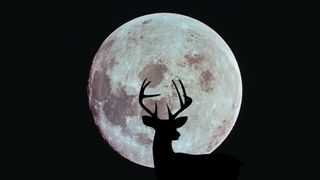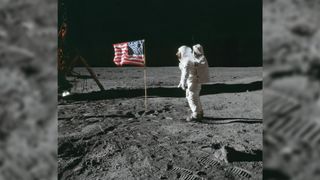Full Buck Moon shines this weekend on Apollo 11 moon landing anniversary
Look up and celebrate both the wonders of the moon and humanity's achievements in space exploration.

When you look up this weekend you will see not only a striking full moon but also a piece of history.
In a rare celestial coincidence, July's full moon will share the spotlight with the 55th anniversary of the Apollo 11 moon landing, providing a unique opportunity to reflect on humanity's achievements in space exploration and our enduring fascination with our closest neighbor.
The July full moon officially occurs on July 21 at 6:17 a.m. EDT (1017 GMT), but the moon will still appear full the night before and after the peak to the casual stargazer. This means it will still appear full during the 55th anniversary of the Apollo 11 moon landing on July 20.
Related: Night sky, July 2024: What you can see tonight
A full moon occurs when the moon is on the opposite side of the sun from Earth and is fully illuminated by the sun. This scene plays out roughly every 29.5 days and marks the midpoint of the lunar cycle.
The July full moon has many names. One of the most common is the Buck Moon, due to the moon occurring when the new antlers of male deer, known as bucks, begin to emerge. It is also called the Thunder Moon after the thunderstorms that are common over parts of the world at this time of year.
When gazing up at the moon this weekend we are also reminded of the monumental achievement that played out 55 years ago, when humans first set foot on the moon. The Apollo 11 mission was the climax of the Apollo program, which pushed human spaceflight forward faster than ever before.
Get the Space.com Newsletter
Breaking space news, the latest updates on rocket launches, skywatching events and more!

Cmdr. Neil Armstrong, Col. Edwin Eugene "Buzz" Aldrin and command module pilot, Lt. Col. Michael Collins made history on July 20, 1969, when Armstrong and Aldrin entered the lunar module nicknamed "Eagle" and separated from the Command Service Module — the "Columbia" — and headed for the lunar surface.
Then at 4:17 p.m. Eastern time. Armstrong notified Houston with the historic words, "Houston, Tranquility Base here. The Eagle has landed."
Over the next three years, five more Apollo missions took astronauts to the lunar surface, with increasingly ambitious and exploratory missions. The Apollo era ended in 1972 with the final mission to the moon, Apollo 17. And we haven't been back since. But that is all about to change with the next era of lunar exploration known as the Artemis program, which aims to place humans back on the moon by 2026.
So when you gaze upon the lunar surface tonight or any night, you'll see where astronauts, rovers and landers have explored another world.
If you want to see the lunar landing sites for yourself check out our Apollo landing sites guide which takes you on an in-depth tour of our rocky companion. And if that isn't enough we've also composed a lunar observation guide so you can take a moon-lit tour of the mountains, craters and lunar seas visible on the surface of the moon.
Editor's Note: If you capture an amazing full moon or night sky photo and want to share it with Space.com for a story or gallery, please send images and comments to spacephotos@space.com.
Join our Space Forums to keep talking space on the latest missions, night sky and more! And if you have a news tip, correction or comment, let us know at: community@space.com.

Daisy Dobrijevic joined Space.com in February 2022 having previously worked for our sister publication All About Space magazine as a staff writer. Before joining us, Daisy completed an editorial internship with the BBC Sky at Night Magazine and worked at the National Space Centre in Leicester, U.K., where she enjoyed communicating space science to the public. In 2021, Daisy completed a PhD in plant physiology and also holds a Master's in Environmental Science, she is currently based in Nottingham, U.K. Daisy is passionate about all things space, with a penchant for solar activity and space weather. She has a strong interest in astrotourism and loves nothing more than a good northern lights chase!
-
TXWaterBird Quote from the article:Reply
"A full moon occurs when the moon is on the opposite side of the sun from Earth and is fully illuminated by the sun."
Huh? I may sound stupid, but when is the moon ever on the opposite side of the sun from Earth?